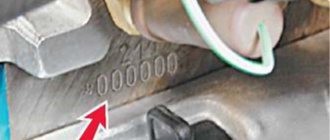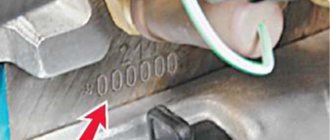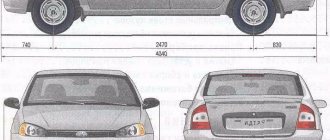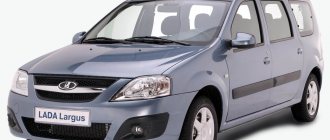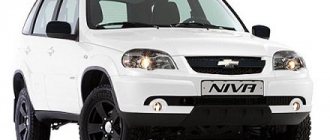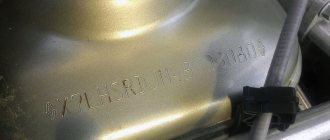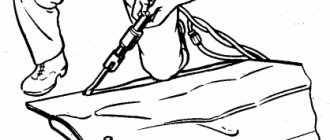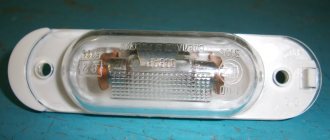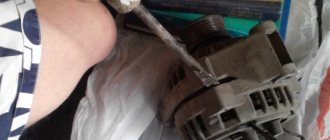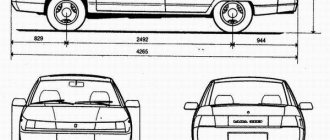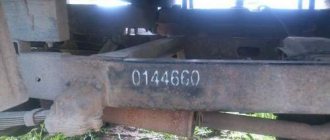To view the VAZ 2112 engine number, the user will need to perform a certain sequence of actions. This is due to the inconvenient location of the marking and its constant contamination. In most modifications of power plants, the coding is applied in one place, regardless of the number of valves and year of manufacture. There are separate versions where the index is moved to another location. The VIN number of the vehicle is highlighted separately. Marking is considered the most important and in demand when purchasing and registering a vehicle.
Where are the body and engine numbers on the VAZ 2110
It is necessary to know where the engine number is located on a VAZ 2110 vehicle. For example, when a car owner wants to buy a new engine, the engine number will help him choose exactly the model his car needs. When buying and selling a vehicle, you also need to know the engine number so as not to mislead the buyer. Many experienced car enthusiasts refuse to buy a car if there is no coding where it is usually located.
- Why do you need an engine number?
- Where is the engine identification number on the VAZ 2110
- Engine number on 16 valve
- Engine number on 8 valve
- Exceptions
- Decoding the number on the VAZ 2110
- What to do if the engine is dirty and the license plate is not visible
- What to do if the number is interrupted
- What to do if the number is unreadable
- Conclusion
Where to look for the VIN code
Most often, the VIN code can be found under the hood, in a special window with a barcode located on the windshield.
Places where you can find the body number Pay attention to the floor trim near the driver's seat or on the driver's door pillar.
“Where is the body number on American cars?” - you ask. American cars are somewhat different from domestic and European cars. Often in an American car you can see the VIN code right on the dashboard on the driver’s side. It can be easily seen in the place where the hood and windshield meet. Duplicating the VIN code provides greater security against theft.
The traditional location of the body number is considered to be such parts as the cylinder block, the cylinder head, and the partition between the engine and the passenger compartment. On vehicles with a frame structure, the manufacturer applies this code to the side members. You may also find this mark visible in the engine compartment. This type of plate is firmly attached to the motor using rivets or screws.
Deciphering the identification number
In addition to detecting the VIN code, the ability to decipher and understand what the letters and numbers in it mean will be a very useful knowledge. Let's look at the meaning of each of the characters in the VIN code:
- Geographical area.
- Country in this zone.
- The third character indicates the vehicle manufacturer. If you see the number 9 at this point, this means that the manufacturer produces less than 500 cars per year.
- In symbols 4 to 8 you can find out information regarding the vehicle body, model of the car itself, equipment and engine.
- The 9th digit is relevant for manufacturers from the USA or China.
- The 10th character indicates the model year of the car.
- The 11th digit will be useful information about the manufacturing company.
- The remaining symbols indicate the sequence in which the car was assembled along the factory assembly line.
Useful tips
1. If you want to purchase a car, then before the meeting you should find out which car contains all the VIN codes, so that you look for them yourself, and not the seller shows you those that are beneficial only to him. If the marked plate is attached with rivets, you should carefully inspect the area around it to see if there are any scratches or small dents near it, since rivets significantly complicate the task of removing such a plate without causing damage nearby. With a plate on the screws, the situation is much simpler; it can be replaced with another one without any difficulty.
2. If your car has been involved in an accident and is severely damaged, body restoration work must be carried out with care so as not to damage the identification number. If it is damaged or you need to completely change the body, find out about the possibility of obtaining legal documents about the work performed, indicating the reasons for the lack of a VIN code.
>Where are the VIN numbers for the VAZ 2112
Location of the engine number on the VAZ-2112
It happens that unknowing car enthusiasts are able to spend more than one hour under the hood of a car looking for the required identification number. The thing is that during operation, some of them can become covered with a thick layer of dirt, which makes them simply unsuitable for visual perception without prior preparation.
Layout of identification numbers under the hood
The photo below shows schematically where all the identification numbers are located under the hood.
The numbers indicate the location of the ID numbers.
- The car number marking ( VIN code ) is located here.
- Under the number two, all the installation passport data.
- The engine number is located under the thermostat housing, on the cylinder block . For convenience, you will have to move the air filter housing to the side.
Engine number here!
In order to check the engine number, you need to have a wire brush and WD-40 on hand in advance to make it easier to read dirty or corroded symbols.
VIN code
The vehicle identification number, in addition to being on the support cup under the hood, is also stamped in the niche for the spare wheel in the trunk . As a rule, they are always readable after a little cleaning with a rag.
Engine number on 16 valve
They changed the thermostat and checked the engine number!
The same cannot be said about the engine number, since its location is subject to constant exposure to road salt, reagents and high moisture. To make it easier to clean and read this number, you need to remove the air filter housing with the corrugation and you will see 2 rows of numbers on the block.
Clean numbers are much easier to read.
The top row indicates the engine model, and the bottom row directly indicates its number.
What to do if a replacement is refused
Unfortunately, this also happens. If you refused orally, it is recommended to apply in writing, doing it like this:
- First provide the vehicle for inspection;
- Then prepare a paper with an appeal;
- Request from the authorities a written refusal with the reasons stated in it and a seal.
We must be prepared for the fact that in most regional traffic police the ceremony of action will have to be pushed through several times. Almost always, the car owner is checked, roughly speaking, for a “sucker”, requiring an allegedly “mandatory” set of certificates. These, for example, include various certificates or documents confirming the native engine of a foreign car, prepared in the country of the manufacturer.
If the traffic police's actions proceed in this direction, the car owner will have to take risks in the name of truth. You will need to submit a statement of claim and a collection of documents to go to court.
Today, the courts are simply inundated with claims and statements regarding the replacement of the body and various elements. Considering the sad experience, the arbiters of legal affairs, unfortunately, do not dare to take the liberty of putting a final point. Citizens are denied some questions, while others are referred to an incomplete collection of documentation.
We can only wait for some progress to be made regarding the issue of replacing the body. In the meantime, to replace the pad for the number, it is better to use the services of service centers.
Location
If the car has a number, then it is definitely registered. In order to figure out where the number is located, you need to open the hood. The rooms can be located in the following places:
- On both sides of the cylinder block.
- Below the hole for the engine oil level dipstick.
- The place where the gearbox and engine connect.
- On the air intake compartment.
- At the base of the corrector.
The engine number of the Lada Priora may be located in these places. You need to look carefully so as not to miss it, although recognizing it will not be difficult for an experienced driver.
Ways to clear a table
Number tables often become dirty and corroded. Do not use coarse sandpaper for cleaning. The exception is very fine sandpaper (2500 - 2000).
Gasoline is often used to clean the table. The printed information will become more contrasting over time. For convenience and speed of the procedure, a dish sponge is usually used. When cleaning, be careful to preserve the metal. When the engine, car body, or VIN tables are corroded, problems often arise and more time is required to carry out registration procedures.
Car body and engine numbers, VIN code - basic information identifying the vehicle. Number combinations must match the data in the documents.
Source
Signs of inoperability of the idle speed sensor
Failures of the idle speed sensor 2112 relate to the electrical or mechanical parts of the device. Signs of malfunction:
- main symptoms: do not hold (“float”), intermittent, weak idle, the vehicle stalls at it, and also when driving in “neutral”, when the throttle valve is retracted, it stalls;
- It is impossible to start in a cold state without opening the damper (until the gas is pressed). On a cold unit, increased speeds are not observed at all; damping occurs after the gear is deactivated when the vehicle is moving;
The symptoms are identical to those for the TPS, but for the latter “CHECK ENGINE” is displayed; if this signal is observed, then it is the one that is broken. The location where the idle speed sensor is located must be distinguished from the location of the TPS.
How to check the engine number when purchasing a used car
To independently check the code, it is enough to study the identification table and the main documents issued for the vehicle.
This may be a registration certificate or PTS. Next you need to follow this procedure:
- inspect the motor number on its body;
- correlate the symbols on the body of the power unit with the symbols indicated in the vehicle registration certificate;
- if there is none, compare the information with the number indicated in the vehicle passport;
- If we are talking about American cars, the number on the engine may not appear, in which case it must be indicated in the PTS.
Separately, it is necessary to check whether the car is listed as stolen, and whether someone has tried to rename individual combinations of symbols. It is also important that all part numbers correspond to the designations specified in the relevant documentation.
Ways to clear a table
Number tables often become dirty and corroded. Do not use coarse sandpaper for cleaning. The exception is very fine sandpaper (2500 - 2000).
Gasoline is often used to clean the table. The printed information will become more contrasting over time. For convenience and speed of the procedure, a dish sponge is usually used. When cleaning, be careful to preserve the metal. When the engine, car body, or VIN tables are corroded, problems often arise and more time is required to carry out registration procedures.
Car body and engine numbers, VIN code - basic information identifying the vehicle. Number combinations must match the data in the documents.
Source
VAZ 2111 where is the body number on
Dear visitors of the “Cars” website! We will be very grateful for your comments on the video clip “VAZ 2111 where is the body number located on”; registration is not required for this. We also ask you to let us know if you have any problems playing the video.
Thanks for the answer. Now I’ll start putting the car in order. The Milky Way is a beautiful color.
12/13/2017 – 23:29 Antonio
Thanks for the review, special respect for the roll bars, otherwise everything is ok on the body, and now I’ll paint the ugly bars with a sponge too. What engine do you have? And how to raise your butt like yours?
28.11.2017 – 09:20 Alexey Pervomaisky
11/18/2017 – 14:48 Vladimir Ilyin
It’s the frameless ones that scratch, with their ends, where the plastic mask is located. And frame ones DO NOT scratch.
08.11.2017 – 00:24 Vladimir Ilyin
What is laquera?
10/18/2017 – 08:08 Vladimir Ilyin
The roof rails do not rust, they are aluminum. The paint is just peeling off. Aluminum falls apart from salt.
09/19/2017 – 05:24 Vladimir Ilyin
I pour the waste into the doors and thresholds. and nothing rusts. I do this in the fall, before winter. Can you tell me how to remove the plastic plate from the back door where the wiper sticks out?
The birth of the “gear”: how 16-valve VAZ engines survived to this day
VAZ cars could rarely boast of a particularly avant-garde design, although they tried to keep up with world trends. There were also some successes - for example, the VAZ-2101 received an overhead engine precisely as a result of the persistence and even tenacity of the Soviet side. And the car of the tenth family, born in a difficult period for the country, could already boast another technical innovation at the development level - a 16-valve engine, like the “hot” modifications of its European classmates. Today we recall the history of the development of the 2112 multi-valve engine, which became the basis for many other VAZ engines - including the most modern ones.
Trends of the times
And using the aggregate base and the G8 platform for the new model, Tolyatti understood that by the time mass production of the VAZ-2110 started, the “eighth” engine would inevitably become obsolete. After all, since the beginning of the eighties, environmental requirements in the world have become more stringent, and the liter capacity has constantly increased. The “charged” modifications of the Volkswagen Golf MKII and Opel Kadett E were practically twice as powerful as the basic versions (and the domestic Samara!), because their engines produced 130-140 “horses”! In addition, it became clear that the engine should not only be more powerful and environmentally friendly, but also more economical than its predecessor.
This could be achieved in several ways. Firstly, VAZ unconditionally accepted the transition to a more modern distributed injection , which theoretically made it possible to comply with any emissions cleanliness standards that were relevant at that time.
Secondly, it was necessary to increase the liter power in order to increase the number of “horses” under the hood, while remaining at the same working volume. After all, not in all countries of the world buyers welcomed “large” engines due to taxes. Yes, and NAMI strictly defined the “liter range” of Soviet technology - VAZs had to fit into the range of 1.2-1.6 liters.
At that time, two ways to “cheer up” had already been tested in practice in the world - installing a turbocharger or switching to a multi-valve cylinder head, where the number of intake and exhaust valves for each cylinder was doubled. Having weighed all the pros and cons, VAZ settled on the second option, since supercharging would require much greater costs and technological innovations, while the scheme with four valves per cylinder was otherwise (“lower”) not much different from eight-valve engine, and due to better filling of the cylinders, the power and torque indicators, all other things being equal, should have increased by 10-15%. This means that, coupled with the “injector”, it was actually possible to extract at least 90 hp from a one and a half liter engine.
Porsche again
Having no personal experience in designing such structures, the VAZ team turned to Porsche specialists “out of old memory.” In addition, the Soviet side needed help from the Germans in aerodynamically fine-tuning the body of the “tens” . The contract signed in 1987 included both aerodynamic work and the development of a 16-valve engine with multipoint injection. At the same time, the working volume remained the same - 1.5 liters.
However, VAZ did not sit idly by, shifting the work of developing a new engine onto the shoulders and hands of German “specialists”! Under the leadership of A. Simulman, a version of a multi-valve block head with cast spark plug wells was assembled - that is, without insert parts.
The design of the 16-valve cylinder head was born in close cooperation with foreign specialists and at the same time turned out to be completely original
The option proposed by Porsche was less technologically advanced - in particular, it required a very complex shaped head gasket, the production of a mold for which Soviet rubber goods specialists simply did not undertake. But the German company Elring, which VAZ specialists contacted, agreed to do everything in four months and 400,000 German marks! Both the first and second did not suit VAZ at all, so they had to. to develop the design using the efforts of the VAZ RTI STC, for which one month and 1,500 rubles were enough.
Technical information
dimensions
Engine compartment layout
- Adsorber.
- Generator.
- Decorative engine cover.
- Intake manifold (on engine 21124 the intake manifold is plastic).
- Throttle valve assembly.
- Brake system reservoir.
- Cooling system expansion tank.
- Washer reservoir.
- Accumulator battery.
- Air filter.
Identification information
The vehicle identification plate is located under the hood on the suspension strut shell on the front passenger side.
identification plate:
- Identification plate:
- Number for ordering spare parts.
- Manufacturer.
- Engine model.
- Execution option.
- Equipment option.
- Rear axle load.
- Front axle load.
- Permitted maximum weight of the vehicle with trailer.
- Permitted maximum vehicle weight.
- An identification number.
The vehicle identification number is a combination of seventeen alphanumeric characters (for example: XTA21103020528829), which are deciphered as follows:
- The first three letters (XTA) are the manufacturer's index. The first symbol is the geographical area (X – Europe); the second is the country (T – Russia); the third is the manufacturing plant (A – JSC AVTOVAZ).
- The next six digits (211030) are the car model.
- A letter of the Latin alphabet or a number (2) is the code of the model year of the car.
| Code | Date of issue |
| A | 01.07.1979-30.06.1980 |
| IN | 01.07.1980-30.06.1981 |
| WITH | 01.07.1981-30.06.1982 |
| D | 01.07.1982-30.06.1983 |
| E | 01.07.1983-30.06.1984 |
| F | 01.07.1984-30.06.1985 |
| G | 01.07.1985-30.06.1986 |
| N | 01.07.1986-30.06.1987 |
| J | 01.07.1987-30.06.1988 |
| TO | 01.07.1988-30.06.1989 |
| L | 01.07.1989-30.06.1990 |
| M | 01.07.1990-30.06.1991 |
| N | 01.07.1991-30.06.1992 |
| R | 01.07.1992-30.06.1993 |
| R | 01.07.1993-30.06.1994 |
| S | 01.07.1994-30.06.1995 |
| T | 01.07.1995-30.06.1996 |
| V | 01.07.1996-30.06.1997 |
| W | 01.07.1997-30.06.1998 |
| X | 01.07.1998-30.06.1999 |
| V | 01.07.1999-30.06.2000 |
| 1 | 01.07.2000-30.06.2001 |
| 2 | 01.07.2001-30.06.2002 |
| 3 | 01.07.2002-30.06.2003 |
| 4 | 01.07.2003-30.06.2004 |
| 5 | 01.07.2004-30.06.2005 |
| 6 | 01.07.2005-30.06.2006 |
| 7 | 01.07.2006-30.06.2007 |
| 8 | 01.07.2007-30.06.2008 |
| 9 | 01.07.2008-30.06.2009 |
| A | 01.07.2009-30.06.2010 |
- The last seven digits (0528829) are the body number.
The body identification number is stamped under the hood on the strut cup on the front passenger side.
Note
: The body identification number is duplicated on the floor of the luggage compartment next to the spare wheel mounting bracket.
The engine number is stamped on the end of the cylinder block under the thermostat housing. In order to read it, you need to remove the air filter or use a mirror.
Note
: For clarity, the engine has been removed.
Source
Engine modifications
Due to the presence of free space inside the block and cylinder head, immediately after the creation of the basic version of the two-shaft 16-valve engine 2112, its versions began to appear:
- 21124 – boosting the internal combustion engine to 89 hp. With. due to the volume of 1.6 l;
- 21126 – modernization of the engine to a power of 98 hp. pp., volume 1.6 l;
- 21128 – maximum combustion chamber volumes 1.8 liters, power increase to 105 liters. With.
In these versions, the valves do not bend; overhauls are needed much less frequently. The first version was created solely to increase volume and comply with Euro-3 standards. Factory tuning was carried out by increasing the block height to 197.1 mm and increasing the piston stroke.
In the second version, the designers tried to ensure the maximum operational life of the units. For this purpose, special cylinder honing is used using the Federal Mogul method. Block 21126 is gray in color, and the number of classes of repair kits for pistons and cylinder liners has been reduced to three in increments of 0.01 mm.
Engine 1.5 l 8 valves carburetor
The ancestor of the ten family, well known to car enthusiasts from the eighth model Lada. Easy to maintain and repair, as a result of a thoughtful, logical layout, dozens moved under the hood, with all the features, including the location of the unit number.
The carburetor four-cylinder engine with a volume of 1 5 liters developed
- Power 72 l s (53 kW);
- torque 104 Nm;
- up to 100 km/h - 14 s.;
- Consumption - 7 6 l/100 km.
